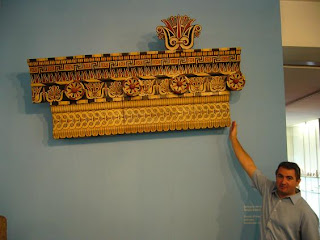




We checked out of the hotel and were picked up by members of the Ottaviano Club. They drove us to the International Instituto Vesuvius for Archeological Science. They are restoring two villas in Ancient Stabiae. The goal of the foundation is to open up an archeological park similar to Pompei and Ercolano. The Ancient ruins in Stabiae were discovered around 1749, but weren’t excavated until the 1950s because the King of Italy wanted it preserved. In the 1950s, a principal of the high school in Castellammare, pioneered the excavation with the help of some janitors and teachers of the school. The institute is partnered with the University of Maryland, and the RAS (Restoring Ancient Stabiae) Foundation was created in 2001.
We toured two well preserved villas, but learned that there are eight total, six of which have yet to be unearthed. The villas were not believed to be inhabited during the eruption of Vesuvius in 79 AD; they were being rebuilt after the earthquake so the owners were probably in Rome.
The people who did the initial excavation in the 1750s were called the Borbone and they utilized a digging technique which involved digging a pit and then digging concentric caves to find treasures. The Borbone took many of the treasures away and are now stored in museums in Naples. Interestingly, the Borbone also destroyed or defaced many of the frescoes that remained so that the value of the ones that they took would be higher.
Alberto took us to the first villa which is named Arianna. The kitchen had an enclosed pool to keep fish so they would always have fresh fish. Jason had an epiphany of this being where the word piscina or pesce came from. Many of the rooms faced the bay and only had three walls allowing for fresh air indicating this was a summer residence. Our second guide, Maria, spoke English beautifully. The second villa was much better preserved and is named San Marco. Maria explained that Stabiae was an important town with a port. Wealthy people built their summer homes here facing the Bay of Naples. San Marco had a large atrium with cubicula, which were small rooms adjacent to the atrium. There was a large entryway big enough to accommodate a chariot and donkey for visitors from Rome. There was a large pool in the middle of the atrium to collect and distribute water to the rest of the house, but once they added indoor plumbing, these were closed off and the pool was only decorative. The atrium was used as a place of business and housed a large safe which held the family treasures to show clients that they could have confidence in their dealings with the owner of the villa.
Throughout the villa, etched graffiti decorates the barren walls. Archaeologists have to really study the etchings to date them because some were from the slaves of the Borbone and others are more recent. There were birds carved into the wall which they have dated to these slaves because they think the slaves wanted to be free and fly away. There was mosaic tile all over the floors except in the kitchen because the slaves were in there. Mosaic tiles were attached to the floor by fish glue or cement.
There was a single skeleton found near these villas and near the skeleton was a bag of treasures. They like to say this thief was caught red-handed by Vesuvius. They had a vomitorium so they could continue eating and partying. If they didn’t have a vomitorium available they vomited in a slave’s mouth.
We then had lunch in the cafeteria of the RAS foundation where we were presented with watches from our Rotary hosts. Next we went to a museum which houses many ancient artifacts from all the area ruins. We learned that many of the local people did not know that Vesuvius was an active volcano because 1,000 years had passed since the last eruption. The valley below Vesuvius was historically a place for wine cultivation. Pompeii was a port where they traded food and wine. We know that wine from Pompeii was transported to Spain and France. We saw iron tools that were used to cultivate food and learned that the local people of the time hunted deer and pigs. Before 1939, many of these ancient artifacts were sold to private collectors in America, during that time the Italy government created a law disallowing the sale of these artifacts so they would stay in Italy.
After the museum, our hosts drove us to the port in Naples so we could take the boat to Ischia. We met up with several Rotaract members who were also heading to the conference, including Nicola from Avellino. During the boat ride we could see Vesuvius, the city of Naples, Capri, Procida, and finally Ischia. We headed to our hotel by taxi and had to immediately get ready for dinner. We saw Giovanni and AnnaMaria outside of dinner. Once we were inside, Giuseppe brought over Tim who was visiting from New Zealand. Tim is doing a bit of a world tour visiting Rotaract conferences. After dinner, Nick, Jason and Martina headed to the club with the Rotaract Conference. We danced the night away and we were some of the first to leave at 3am.






















































